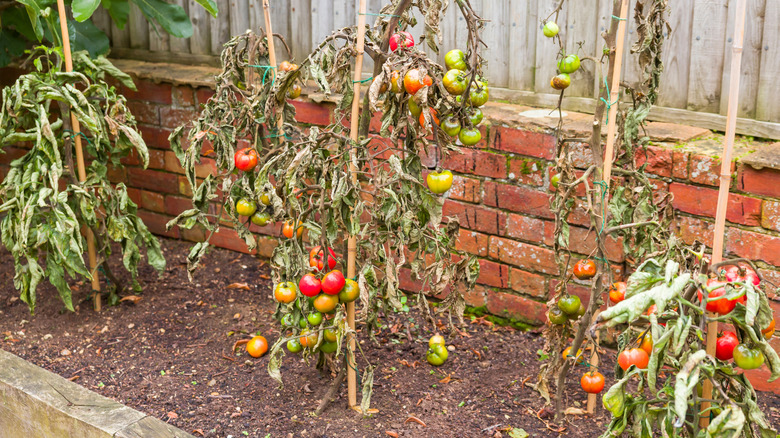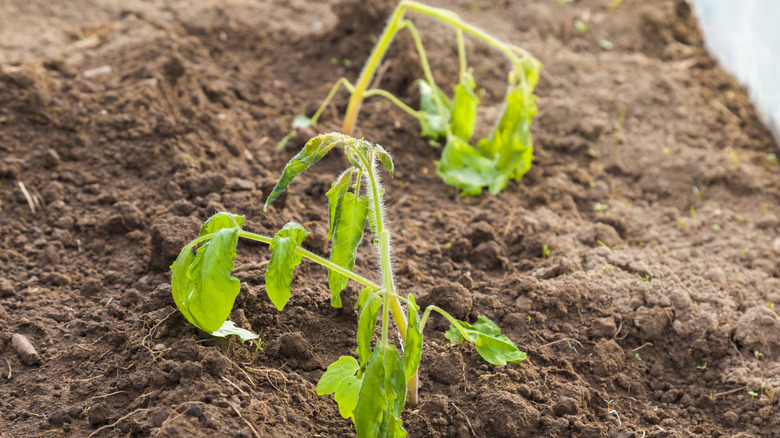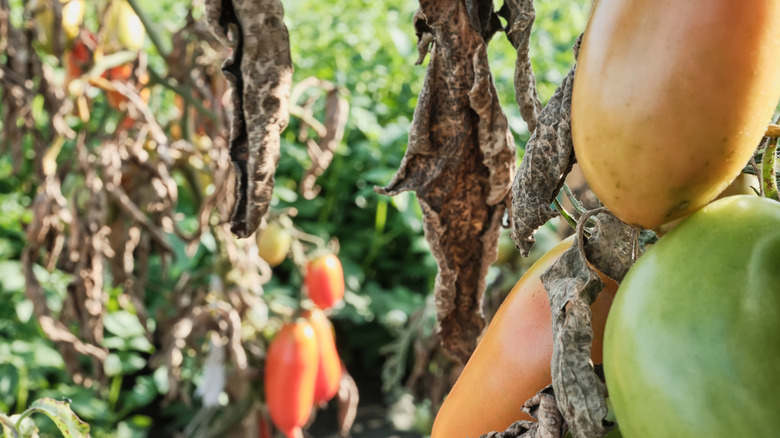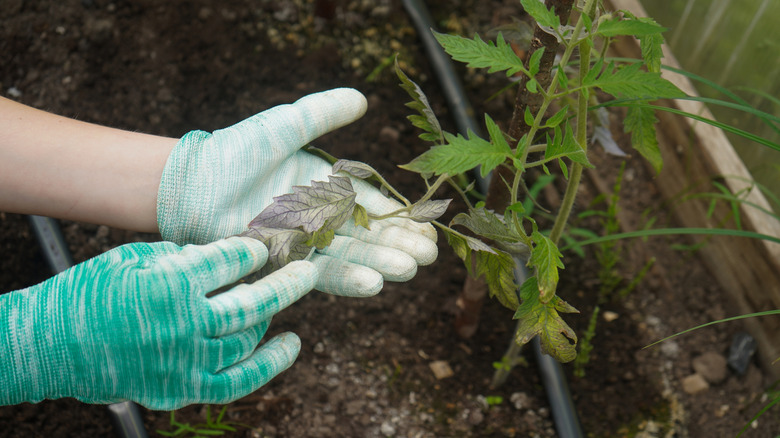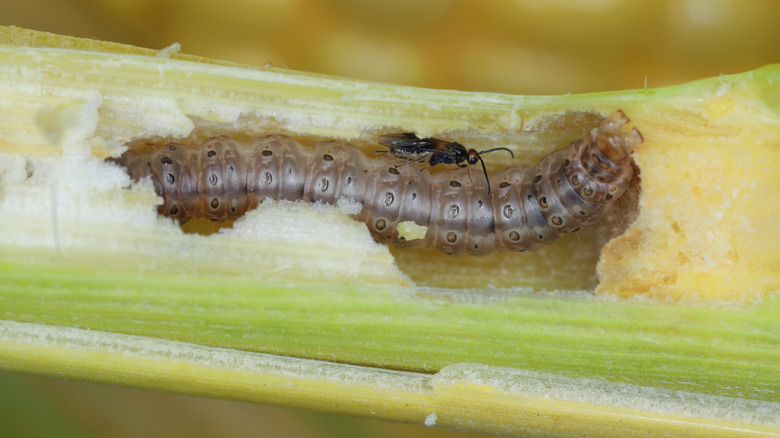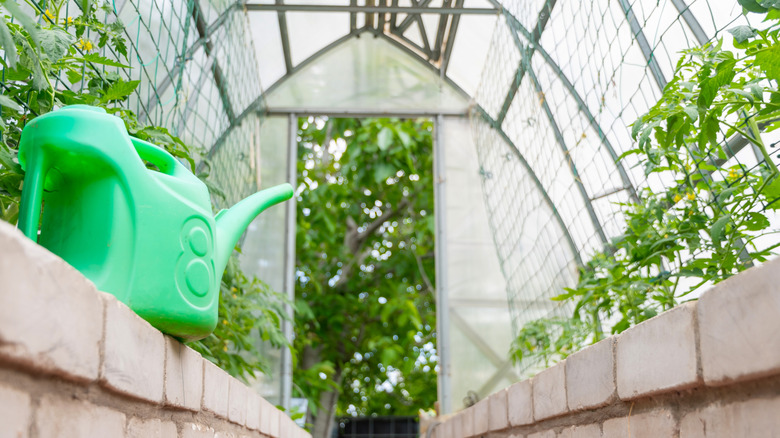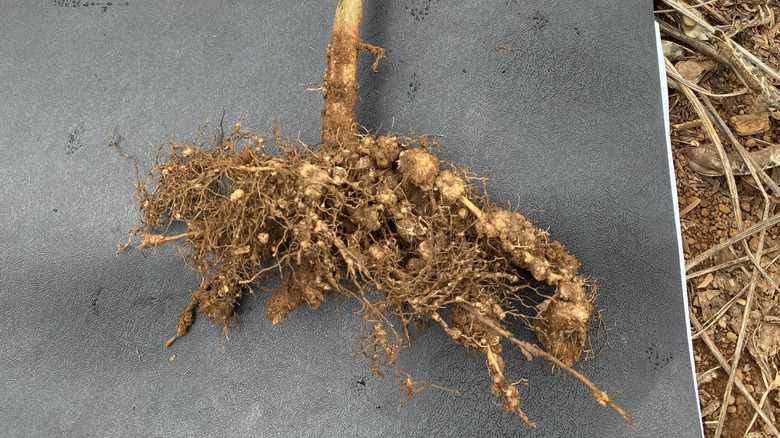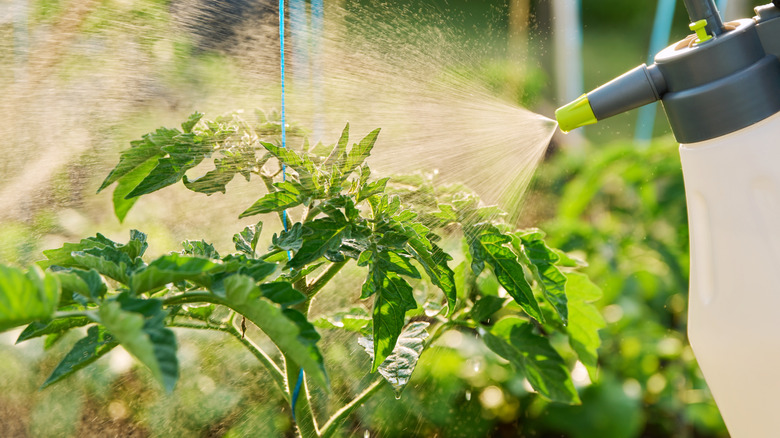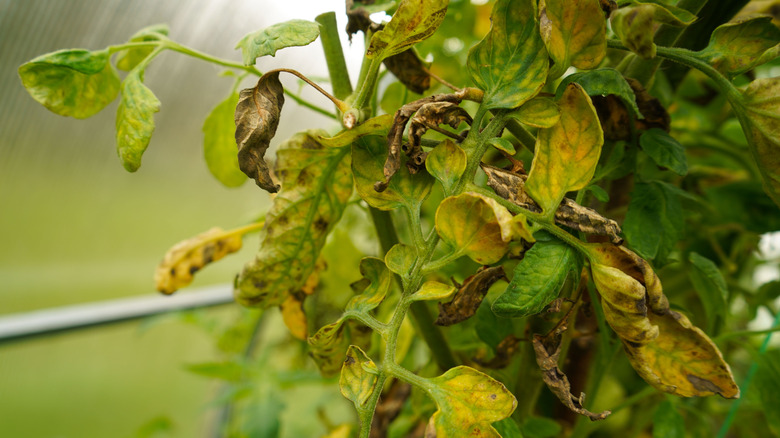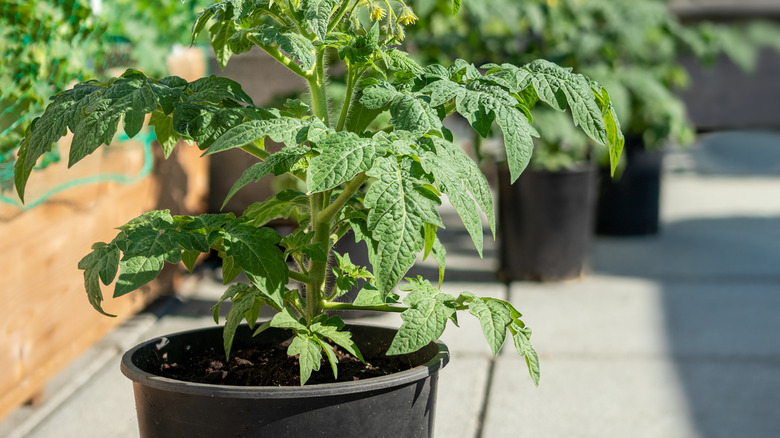11 Possible Reasons Your Tomato Plants Are Wilting
We may receive a commission on purchases made from links.
Here's an understatement of the century: Gardening is hard. You work so diligently to give your plants the best conditions possible, yet they seemed determined to undermine your efforts at every turn. The worst part is that you may not even know what's caused the issue or what you can do about it. And while we wish we could give you bespoke gardening advice, we know you're busy and just need answers ASAP. So, let's cover a plant that sometimes feels like comes pre-bundled with problems: tomato plants.
A wilting tomato plant is like a garden's cry for help, because it's a clear sign that something bad is going on underneath the soil line. The most frustrating part is determining the cause since tomato plant's wilt for a variety of issues. So, let's break down 11 of the most likely culprits making your tomato plants look the tomato equivalent of the Charlie Brown Christmas tree and what you can do about it to get your plants back to their lush-looking selves.
It has water stress due to underwatering
If your tomato plants start to look sad and droopy, the first step is to check your soil's moisture levels, because the problem could be as simple as them needing a drink of water. When a tomato plant runs out of accessible water, its cells lose what's known as turgor pressure — the hydrostatic force pushing against the plant's cell walls. It's like filling a balloon with water; the more water, the firmer the structure. The less water, the lower the force pushing against the balloon's walls, the more wrinkly and flimsy it becomes. The same goes for your tomatoes; when the turgor pressure is low, the plant's cells are too flimsy to hold the stems, leaves, and fruits, so it succumbs to water stress and begins to wilt.
Luckily, this is a pretty easy way to bring a tomato plant back if you catch it early: Give your plant's soil a thorough watering. Tomato plants need around 1 inch of water per week for good turgor pressure and overall health. To maintain the best moisture level for your plants, try watering in the morning before the heat hits its peak and aim your hose or watering can at the soil instead of the plant, so that water reaches the roots and doesn't end up causing foliar diseases. If all goes well, your plant should bounce back within a day or so.
Your plant has contracted a fungal wilting disease
If your water routine seems fine, but your plants are still wilting, it could be a sign of a fungal wilting disease. Fungal wilts are caused by fungi like Verticillium albo-atrum, Verticillium dahliae, Fusarium oxysporum f. sp. lycopersici, or Athelia rolfsii. These fungi work by attacking the plant's xylem, essentially clogging its internal plumbing and preventing water and nutrients from traveling from the roots to the leaves. Signs you're dealing with Verticillium will be V-shaped lesions, wilting, stunted growth, and yellowing lower leaves. Signs you're dealing with Fusarium are similar to Verticillium, except you'll notice that only one side of the plant is wilting. If you notice wilting and see white mold around the base of your plant, too, then you've most likely got the Athelia rolfsii fungal strain, which causes a specific type of wilt: Southern blight.
Sadly, there's no successful method for treating fungal diseases, so your best bet is to toss the plants, as well as the first 3 inches of soil in a 12 inch radius, and start with fresh plants. Don't put your discarded plants or soil in the compost bin, as this could end up spreading again. Till the remaining soil 8 to 10 inches deep so that you kill any remaining fungi. Also, be sure to sterilize all of your garden tools, gloves, kneeling pads, and whatever else has touched the soil, so that the fungi can't spread. However, you may want to play it safe and just wait a full two years before replanting, especially if you have cold winters, since fungi usually can't make it through temperatures below 14 degrees Fahrenheit. When you're ready to replant, inspect the soil, new seedlings or plants, mulch, and any amendments for signs of fungi — white mold or lots of moisture — and only use wilt-resistant varieties.
Your plant has contracted a bacterial wilting disease
If your tomato plant has begun to wilt, yet still has green leaves, you may be dealing with a bacterial disease. An organism called Ralstonia solanacearum is the bacteria that infects tomato plants and can cause sudden wilting, even when the plant initially has enough water. Entering via damaged stems that typically happen during transplant shock or from pests, it acts like a fungi and blocks the plant's stems from delivering water and nutrients by filling it with slime (gross, we know), which causes the wilting. If you cut a stem and brown or yellow slime oozes out, you know you're dealing with R. solanacearum.
Like fungal infections, bacterial-caused wilts are really hard to treat, especially since they can live in the soil for years. This is another case when the best solution is to call it a day and scrap your plants, putting them in the trash bin instead of compost and thoroughly sterilize any tools or gear that's touched the infected soil. To be entirely safe, you should wait at least three years before growing tomatoes, or any other nightshade, in the same area. The silver lining, however, is that if you want to keep growing tomatoes and can get your hands on a bacteria-resistant variety, like 'Invincible,' you now have an excuse to expand your garden. After all, you need fresh space to grow those delicious tomatoes, right? It's okay, you can blame us for the idea.
Stalk borers have infested your plant
Let's say you're keeping a good water routine and are fairly certain you're not dealing with an infection, but your tomatoes are still wilting. If you've ruled out the other culprits, then you may have a stalk borer (Papaipema nebris) pest infestation. Stalk borers aren't exclusive to tomato plants and have been known to damage more than one plant at a time, so be very careful, as they can ruin your whole crop yield. The pest's caterpillar larvae bore into the stem — hence the name — and tunnel inside, causing the plant's stems to be too weak to hold itself up, so it wilts. They'll also occasionally feed on leaves, so if your tomato plant's leaves look pretty tattered in addition to the stem wilt, it could be these guys.
Stalk borers are hard to spot as they bore tiny holes, but if you look carefully and see a purple and cream caterpillar, you know what you're dealing with. Pesticides and insecticides rarely work on these jerks because they bury themselves so deep into the stems. Your best bet is to remove the infected plants and destroy them, caterpillar and all. They like to live in tall grassy/weedy areas, so practice good preventative care by keeping the lawn around your garden cut low.
It's been exceptionally hot outside
When a heatwave hits, it's not just the temperature that affects your tomato plants; the faster evaporation in hot weather can also cause your plants leaves to curl and wilt. Even if you've been really good at early morning waterings, extremely hot summer days can cause rapid evapotranspiration, or the one-two punch of water evaporating from the soil and transpiring from the leaves. The top layer of soil and the leaves will lose water so fast that the roots simply can't pump enough water back to the leaves to compensate, so they shut down the system to conserve resources, causing the plant to droop and curl.
Since you can't stop heatwaves from happening, you'll need to protect your plants from wilting in the summer heat. Install a shade cloth over a hoop house — you can even DIY one with hula hoops — or on tall bamboo stakes. Shade cloths come in different strengths and colors, but we like Farm Plastic Supply's 50% White Shade Cloth, because the white will reflect light instead of absorbing it the way black cloths might. It's also a good idea to mulch around your plants to help lock in moisture and prevent any shallow roots from burning. If you still notice your plants wilting in the afternoon, give them a good, deep watering as soon as the sun goes down so they have the chance to soak up fresh water and recover before the next day. However, don't do this often, as repeatedly watering late in the day can lead to a bunch of problems.
Your plants are close to a walnut tree
One thing some gardeners don't consider until it's too late is their tomato plants' neighbors. If your tomato plants are wilting and everything seems fine, care wise, take a look around. If you happen to notice a black walnut tree (Juglans nigra) or butternut tree (Juglans cinera) within around 50 feet of your garden, you've officially got a juglone problem. Juglone is a chemical produced by these trees that seeps into the soil as a way to thin out competition around them. Some plants are immune, but solanaceous crops, like tomatoes, are not, and once it hits your tomato plant's roots, it acts like a strong poison and the plant will wilt or even die.
Now, we need to clarify something about the 50 feet rule. These trees are able to produce enough juglone to toxify the soil as far as 50 to 80 feet from its drip line, which is the area directly under its outer canopy, making them one of the worst plants to grow near tomatoes simply due to their reach. If you've got a big walnut tree, you'll need to go even farther from it to protect your tomatoes. If space is limited or you want to play it safe, plant your tomatoes in containers or in raised beds with a barrier at the bottom to ensure the toxic juglone doesn't make its way to your plant's roots.
Root knot nematodes have invaded your garden
Some nematodes are beneficial for gardens, as they'll help manage the insect population and reduce the need for pesticides. But then there's the root knot nematode (Meloidogyne spp.), a really small jerk that can cause plants to stunt their growth, wilt, and produce fewer crops. Root knot nematodes are about 1/10th the size of a pinhead, so you're not going to spot them with your naked eye. They rarely live uniformly throughout your soil, so if you start noticing clusters of plants wilting while others look fine, it could be nematodes. They attack plants by feeding on the roots, causing them to develop galls or knots, sort of like scar tissue. The knots then stop the root from doing its job of delivering water or nutrients to the plant, essentially starving it.
There are three good ways to stop a nematode outbreak. First, rotate crops so that they don't get too comfortable with a food source. Next, use cover crops as a way of inviting nematode predators to come around. French marigolds (Tagetes patula) are the best. as they release a chemical, alpa-terthienyl, that's toxic to root knot nematode adults and larvae, and prevents the eggs from hatching. Also, make sure to weed your garden regularly if you're using cover crops, so the nematodes don't have a non-toxic place to hide. Finally, amend your soil with organic matter like compost or natural mulches, as these will increase beneficial fungi in the soil that are predators of adult nematodes and nematode eggs.
Your plant was exposed to herbicides
If your tomato plants were accidentally exposed to an herbicide, that's most likely the cause of wilting. Tomato plants are particularly finicky about herbicides, and their sensitivity means even a small dose will be enough to cause wilting, no fruit production, or even kill off the plant entirely. If you notice older leaves becoming distorted, curling, or cupping, younger leaves staying long and slender, or its fruits turning "catfaced" and misshapen, there's a chance your plant's dealing with herbicide toxicity.
Sadly, tomato plants rarely recover from herbicide poisoning, so your best bet is to plant a new batch of seedlings. Be very careful about using herbicides in your garden, especially ones that tend to drift on windy days, like 2,4-D. dicamba, and glyphosate. You can always try to control weeds naturally with an easy-to-make solution, or just practice good gardening hygiene by manually removing weeds when you see them.
Your tomatoes have an ethylene injury
If you notice your tomato plant has begun to wilt, but, paradoxically, feels firm instead of droopy, you could be dealing with an ethylene injury. Ethylene is a colorless, odorless gas that's naturally emitted from plants to help their fruits ripen, but it can also come from a furnace or heater nearby and typically shows up in winter when plants are being kept warm in heated high tunnels or greenhouses. Tomato plants are very sensitive to ethylene gas and will start showing signs — bud drop, yellowing, stunted growth, and curled and wilted-looking leaves that feel healthy to the touch — within 24 hours of exposure.
Luckily, tomato plants can bounce back if the source of ethylene is removed soon after symptoms appear. Try to move your tomatoes away from ripening plants and have any heating appliances that are nearby checked by a professional. The damaged or lost buds and leaves won't come back, unfortunately, but the plant may still be able to pull through once the air is literally clear.
Your plant has tomato pith necrosis
Tomato pith necrosis (TPN) is one of the trickier causes of wilting to deal with, since it spreads quickly and can cause significant damage once inoculation begins. TPN is caused by bacteria species from the Pseudomonas genus that flourish in humid areas, like greenhouses and high tunnels. The bacteria gains entry via wounds and will work quickly to spread throughout the plant, becoming so dense that it causes stems to split, preventing water delivery. The dehydrated stems and leaves then begin to wilt, yellow, and die off. If you notice what looks like stab wounds along stems that are full of little nubs, those are adventitious roots and a sign of TPN. Other signs include browning stems, bands of necrotic tissue near the lead petioles, and leaf blades blackening, in addition to wilting.
Pseudomonas are weak, sissy bacteria and only infect damaged tissue, so the best thing you can do is stay on top of your gardening chores, so your tomato plants stay healthy. Don't play fast and loose with your nitrogen-heavy fertilizers, either, as excessive nitrogen makes your tomato plants more susceptible to TPD. Stay on top of sterilizing your gardening tools to prevent spreading and toss any debris or dead plants that are infected. There are currently no interventions available once TPN sets in, so prevention is the best thing you can do.
You're using the wrong potting soil in your containers
Specialty soils can get expensive, so we know it's tempting to just grab the cheapest bag of garden soil for your container plants. But the wrong potting soil can be a death sentence for your tomato plants. Plain garden soil can be extremely dense, because there are no additives, making it difficult to remove excess water away from the roots, starving them of oxygen. The plant's roots get weak and die off so there's nothing to deliver the essential nutrients and moisture your plant needs to thrive. As it uses up its resources, the plant begins to wilt to conserve energy, but will eventually succumb and die if you don't intervene.
If you're noticing wilting or curling leaves, check the soil's moisture by dipping your finger in at least a knuckle deep and pull it out. If there's debris on your finger, that means the soil is moist, and if you feel a lot of moisture or begin to smell that decay aroma, you need to act fast. First, pull the plant out of the soil and clean it off — roots and all — as best you can. Next, attend to any rotted roots and prune them; they're not coming back. Check your plant's pot and make sure it has enough drainage holes to push excess water out and that the holes aren't clogged — this is key for preventing root rot in tomato plants. Then, repot your tomato plant in fresh soil that has additives that help drainage, like perlite, vermiculite, or LECA. The soil should be chunky due to the additives, so that the roots can access oxygen, spread, and so that water can easily drain out. If you catch it in time, your plant should recover.
